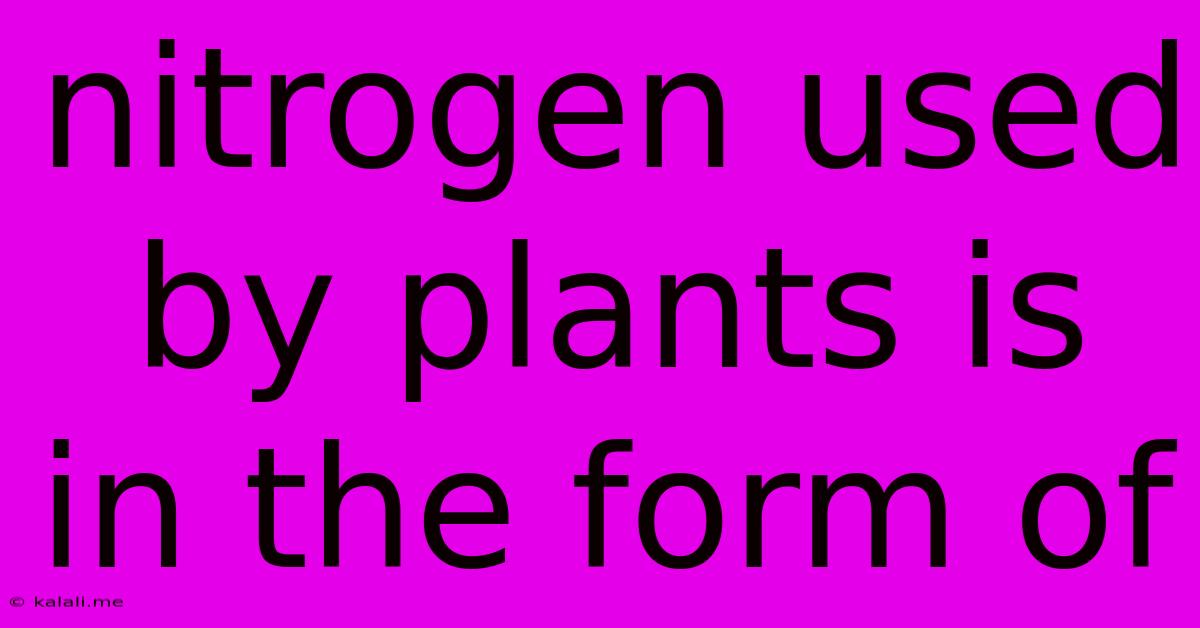Nitrogen Used By Plants Is In The Form Of
Kalali
Jun 16, 2025 · 3 min read

Table of Contents
Nitrogen Used by Plants: Understanding Nitrate and Ammonium
Plants are essential for life on Earth, forming the base of most food chains and providing us with oxygen. But did you know that the form in which plants absorb nitrogen, a crucial nutrient for their growth, is a key factor in their overall health and productivity? This article will delve into the two primary forms of nitrogen utilized by plants: nitrate and ammonium. Understanding these forms is vital for anyone interested in plant physiology, agriculture, or sustainable gardening.
Meta Description: Discover the two main forms of nitrogen absorbed by plants: nitrate and ammonium. Learn about their uptake, benefits, and implications for plant health and agricultural practices.
Nitrate (NO₃⁻): The Dominant Form
Nitrate is the most common form of nitrogen absorbed by plants, particularly in well-aerated soils. It's highly mobile in the soil, meaning it can easily move with water. This mobility allows plants to access nitrate from a larger area surrounding their roots. However, this mobility also presents a challenge, as nitrate can be leached from the soil by heavy rainfall or irrigation, leading to nutrient loss and potential environmental pollution.
Advantages of Nitrate Uptake:
- High Mobility: Easily accessible to plant roots.
- Wide Availability: Present in most soils, especially those well-supplied with oxygen.
- Less Toxic at Higher Concentrations: Compared to ammonium, plants can tolerate higher nitrate concentrations.
Disadvantages of Nitrate Uptake:
- Leaching: Prone to loss from the soil due to its solubility in water.
- Energy-Intensive Uptake: Requires energy from the plant to transport into the roots.
- Potential for Groundwater Contamination: Excess nitrate can contaminate groundwater sources.
Ammonium (NH₄⁺): A Direct Route
Ammonium, another crucial form of nitrogen, is directly available to plants. It's often preferred by plants in waterlogged or anaerobic conditions where nitrification (the conversion of ammonium to nitrate) is inhibited. Compared to nitrate, ammonium uptake is less energy-intensive for plants. However, ammonium can be toxic to plants at high concentrations. This toxicity stems from its ability to interfere with the plant's metabolic processes.
Advantages of Ammonium Uptake:
- Less Energy-Intensive Uptake: Requires less energy for absorption by roots.
- Less Susceptible to Leaching: Less mobile in the soil compared to nitrate.
- Better Availability in Waterlogged Soils: Favored in anaerobic conditions.
Disadvantages of Ammonium Uptake:
- Toxicity at High Concentrations: Can inhibit plant growth if present in excess.
- Acidification of Soil: Ammonium uptake can acidify the soil, potentially affecting nutrient availability.
- Lower Mobility: May limit availability to roots, especially in well-aerated soils.
The Role of Soil Microorganisms
It's important to note that the conversion between ammonium and nitrate is heavily influenced by soil microorganisms. Bacteria play a critical role in the nitrogen cycle, converting organic nitrogen into ammonium (ammonification) and then further converting ammonium into nitrate (nitrification). These processes are vital for making nitrogen available to plants. Understanding the microbial activity within the soil can therefore help optimize nutrient availability for plants.
Optimizing Nitrogen Availability for Plants
Whether plants primarily utilize nitrate or ammonium depends on various factors, including soil type, soil conditions (aeration, moisture), and the presence of microorganisms. Agricultural practices like fertilization and irrigation management should consider these factors to optimize nitrogen availability and promote healthy plant growth. Sustainable practices that minimize nutrient loss and promote healthy soil ecosystems are crucial for long-term agricultural success and environmental protection.
This knowledge helps us understand the complex relationship between plants and their nutrient environment. By appreciating the different forms of nitrogen uptake, we can better manage soil fertility and contribute to sustainable agricultural practices.
Latest Posts
Latest Posts
-
How To Create Clickable Image In Html
Jun 16, 2025
-
What Are The Factors Of 121
Jun 16, 2025
-
What Is A Theme Of The Passage
Jun 16, 2025
-
A Company That Provides Access To The Internet
Jun 16, 2025
-
Which Word Is Closest In Meaning To The Underlined Word
Jun 16, 2025
Related Post
Thank you for visiting our website which covers about Nitrogen Used By Plants Is In The Form Of . We hope the information provided has been useful to you. Feel free to contact us if you have any questions or need further assistance. See you next time and don't miss to bookmark.